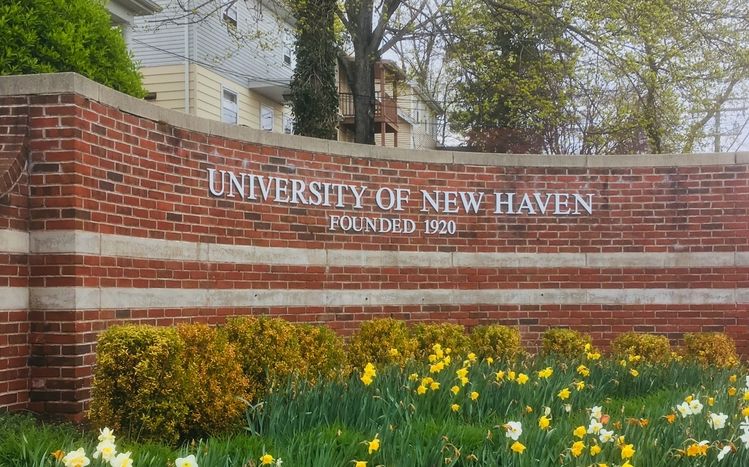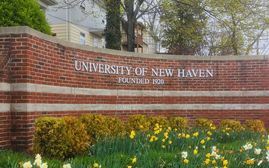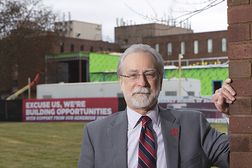Processing Your Payment
Please do not leave this page until complete. This can take a few moments.
- News
-
Editions
View Digital Editions
Biweekly Issues
- April 29, 2024
- April 15, 2024
- April 1, 2024
- March 18, 2024
- March 4, 2024
- February 19, 2024
- February 5, 2024
- January 22, 2024
- January 8, 2024
- + More
Special Editions
- Lists
- Viewpoints
- HBJ Events
- Business Calendar
- Custom Content
Online or in person, no easy course for colleges in the fall
 Photo | Contributed
Photo | Contributed
In the college admissions field it is known as the “summer melt” — prospective students who commit to attend a college or university and then don’t matriculate in the fall. Admissions officials fear this year’s melt could be a torrent due to the COVID-19 pandemic, and will exacerbate what has become a historically difficult year for the state’s college and universities.
“This is unprecedented … surreal,” said George S. Synodi, the University of New Haven’s vice-president for finance and administration.
The uncertainty about college in the fall is a huge nuisance for parents and students, but it could be much worse for the colleges, which have already lost millions of dollars following the March shutdown.
“We expect that the colleges and universities we rate will face an unprecedented level of operating stress and tightened liquidity, which will worsen the longer and deeper the pandemic lasts,” said an April 29 report from the credit rating agency S&P Global.
Most schools haven’t announced if they will open online or bring students back in the fall, but both options carry significant risks. Making matters worse, colleges were already being challenged by economic and demographic factors before the coronavirus made its ugly presence felt. Declining college enrollment, loss of international students, more demand for aid and other factors compound the difficulties.
Great unknown
As the S&P report indicates, much depends on the path of the pandemic.
Last week, the higher education subcommittee of Gov. Ned Lamont’s Reopen CT Task Force issued a report recommending a phased reopening of the state’s colleges. It would, at the school’s discretion, start with non-classroom functions such as libraries and laboratories this month, gradually adding programs over the summer and then bringing back large numbers of undergraduates in the fall.
All of which comes with a major caveat: “if prevailing health conditions make it possible.”
To make a successful reopening possible, the prevalence of COVID-19 must continue to decline. Widespread testing and contact tracing must be available. If there is another wave of the fearsome illness in the fall, schools should have a plan to shut down again, the report recommends.
At this point everything is possible.
“My crystal ball is a very unreliable instrument. Nobody knows what to expect in the fall,” said Jo Ellen Parker, vice-president of the Washington-based Council of Independent Colleges.
Everybody — educators, students and parents — would like to see students back at safe and functioning campuses in the fall. There’s a lot riding on it.
The Re-Open Task Force report observes that “state institutions and better-endowed private institutions will bear significant financial losses if they cannot reopen in the fall, or if they open for only a fraction of their students. For less well-endowed private institutions, the financial risks are existential.”
When this is over, things are likely to be different at old alma mater.
Other factors
It isn’t as if the period just before the COVID-19 outbreak was the best of times for most colleges.
College enrollment had been dropping for several years, according to the National Student Clearninghouse Research Center and others, meaning that colleges were competing for fewer students.
Also, years of stagnant or barely growing middle-class wages have put pressure on colleges to provide more student aid. The recent Great Depression-like spike in unemployment will increase that challenge.
One group that could be reliably counted on to pay full freight was international students, but that cohort also is shrinking and expected to fall dramatically this year. International students have been dissuaded by White House anti-immigrant rhetoric and travel bans, according to a report by the international education group NAFSA, and enticed by opportunities at colleges in China, Canada and the UK, where a degree can be earned in three years.
So the last thing the schools needed was an order to shut down in mid-March. But shut down they did, canceling spring sports and other activities and moving classes online. Most residential colleges refunded millions of dollars in room and board and activity fees. In what feels like piling on, parents — including one University of Connecticut parent — have sued schools across the country, claiming online classes weren’t worth the tuition they paid and hence should be reimbursed.
The colleges did receive some money from the federal CARES Act, but Jennifer Widness, president of the Connecticut Conference of Independent Colleges, which represents 15 independent, nonprofit colleges across the state, said it covered less than a quarter of the losses her schools endured.
With their finances in jeopardy, colleges enacted serious cost-cutting measures, some combination of voluntary or mandatory furloughs, voluntary salary cuts for top administrators, spending freezes, early retirements, and other measures. For example, the University of New Haven furloughed 173 non-teaching staff through the end of July and partially furloughed another 75 through the end of August.
Meanwhile, college leaders started planning for all the possible fall scenarios, from all-online to various strategies to bring students back to campus. “At least we are able to plan this time,” said Widness.
No one wants to go all online. Residential colleges would lose room and board revenues, probably have to discount tuition and not be able to offer the social milieu — forget Frisbee on the quad — and close faculty contact generally associated with the college experience.
But bringing students back to campus, particularly residential campuses, brings its own set of challenges. Fundamentally, how do you keep 18 – to 22-year olds away from each other? How do you teach a class of 30 when social distancing would only allow, say, 12 in a classroom? How do older faculty and student-facing staff, who are thought to be more vulnerable to the coronavirus, approach their jobs?
Schools are looking at all kinds of hybrid options; a shorter semester, a longer school week to reduce density on campus, classes taught partially online and partially in person. Technology may help. For example, there is a course model called HyFlex, which gives students the option of attending class sessions in the classroom, online, or both.
Perhaps the ultimate question is whether parents, much as they want their offspring to spring off to college, will buy into the program, whatever it turns out to be.
All of this uncertainty means the size of the melt is still a question mark. Synodi said his school’s fall registration numbers are good but added, “a lot of parents will make late decisions.”
The fall
Though surveys at this point must be taken cum grano salis, as a classics major might say, some suggest that student populations at four-year colleges will be down as much as 20 percent in the fall. The University of Kentucky, for example, expected 5,750 freshmen pre-COVID, but now estimates the number will be closer to 4,500. That and reductions in other classes could cost the school $27 million.
The surveys suggest students will take gap years, defer admission until the spring or transfer to less expensive community or online colleges. This doesn’t bode well for the college the student was going to attend. “Fewer students means less tuition revenue … fewer students on campus means less revenue from student fees and room and board,” said Damion Pechota, a policy analyst for the Education Commission on the States, in an email exchange.
So colleges are in a tough spot if they don’t open, but facing real challenges if they do.
Does this mean, as some commentators have suggested, that some schools will be overwhelmed and forced to close? This is very hard to predict, said Susan Fitzgerald, who analyzes the financial strength of colleges for the Moody’s Investors Service bond rating agency. She spoke at a webinar titled “Will the Coronavirus Put Your College Out of Business” sponsored by the Education Writers Association.
While a handful of small and little-known colleges in New England have folded or merged in the last couple of years, the higher education sector in general is “durable and resilient.” She said even colleges in distress often find a way to stay afloat.
But, citing “unprecedented enrollment uncertainty,” Moody’s has downgraded its outlook for the higher education sector from stable to negative. S&P has done the same for scores of the colleges it rates, including the universities of Hartford and New Haven. Officials at both schools say they are fiscally sound and in no danger of collapse.
University of Hartford president Gregory Woodward said in an email the “significance of the rating is minimal at this time; we have a solid balance sheet, appropriate debt, and a plan for the future.” Synodi said much the same thing about UNH.
Last fall, Forbes analyzed the financial health of all private, nonprofit colleges with more than 500 students. Two Connecticut colleges received D ratings: Mitchell College in New London and the University of Bridgeport, which got one of the lowest ratings in the survey.
In an article about the rating, Forbes called UB, which was once controlled by Rev. Sun Myung Moon’s Unification Church, “long-troubled,” and a “money-losing university.” Perhaps most damningly, the analysts wrote “Nearly every financial ratio we track looks abysmal.”
UB president Laura Skandera Trombley protested the rating in December, saying improvements were being made on several fronts. She then left the post last month, after less than two years in office, to become president of Southwestern University in Georgetown, Texas.
UB staff did not respond to several calls and emails from The Mirror.
Mitchell was rated only slightly higher than UB, but acting president Catherine Wright said in an email that a number of innovations have put the small school “on a promising path forward.”
Post-COVID
On a slightly brighter side, colleges employ a lot of smart people, and they are working together, between departments internally and with colleagues at other colleges, to figure this out.
“It’s a big think tank,” said Ken Steen, a professor of composition and music theory at the University of Hartford’s Hartt School.
So at this point there’s no reason to think most, if not all, of the state’s colleges will make it through this trying time. Connecticut’s colleges and universities are among its crown jewels. They employ 45,000 state residents, spend more than $10 billion annually, and educate 190,000 students, according to the Re-Open report. Many of their students remain in the state to enhance the workforce and become leaders in business, government and the arts. Colleges are helping to fight the coronavirus, from researchers at UConn and Yale to students at Goodwin and Wesleyan universities using 3-D printers and other high-tech equipment to make masks and shields.
But the pandemic may spur change — change that in some cases was already underway. With the staggering costs and frightening prospect of student debt, many parents and students want to see a return on investment, e.g., a job, after graduation. This has pushed many schools toward more career-oriented curricula.
Does it challenge the model of the small liberal arts college? “It’s not either/or,” said Jo Ellen Parker. “We can have liberally educated professionals.”
The pandemic experience will likely lead to broader use of online or distance learning. This is suggested by the experience of Post University, a private, for-profit college in Waterbury.
Post is a kind of hybrid. It has a physical campus with dorms and classrooms that serve about 1,000 students, but also a large and sophisticated online learning operation that serves about 15,000 students at any given time, said college president John. L. Hopkins.
Post was a pioneer in distance learning, having been at it for more than 20 years, and has built a technical and pedagogical infrastructure for online education. It isn’t just, as might be thought, a professor lecturing into a camera. Post students have interactive classes with flexible schedules, as well as access to academic and career counselors, tutors, online student activities, even online student government. “It is a virtual campus,” Hopkins said. “We think online is the future.”
The total cost for a student seeking a bachelor’s degree is about $70,000, he said. In comparison, it will cost incoming freshmen at Wesleyan University in Middletown $75,800 for their first year alone. Other private, liberal arts schools, like Connecticut College and Yale University, are similarly priced.
Finally, most colleges will face fiscal challenges in the immediate post-COVID period. Joanne Berger-Sweeney, president of Trinity College, said colleges have three main sources of revenue: tuition, endowment interest and philanthropy.
“Each stream has been reduced,” she said. “Every residential college in the country is going to have to learn to live with less revenue.”
Related Content

2022 Giving Guide
This special edition informs and connects businesses with nonprofit organizations that are aligned with what they care about. Each nonprofit profile provides a crisp snapshot of the organization’s mission, goals, area of service, giving and volunteer opportunities and board leadership.
Learn more
Subscribe
Hartford Business Journal provides the top coverage of news, trends, data, politics and personalities of the area’s business community. Get the news and information you need from the award-winning writers at HBJ. Don’t miss out - subscribe today.
Subscribe
2024 Book of Lists
Delivering Vital Marketplace Content and Context to Senior Decision Makers Throughout Greater Hartford and the State ... All Year Long!
Read Here-
2022 Giving Guide
This special edition informs and connects businesses with nonprofit organizations that are aligned with what they care about. Each nonprofit profile provides a crisp snapshot of the organization’s mission, goals, area of service, giving and volunteer opportunities and board leadership.
-
Subscribe
Hartford Business Journal provides the top coverage of news, trends, data, politics and personalities of the area’s business community. Get the news and information you need from the award-winning writers at HBJ. Don’t miss out - subscribe today.
-
2024 Book of Lists
Delivering Vital Marketplace Content and Context to Senior Decision Makers Throughout Greater Hartford and the State ... All Year Long!
ABOUT
ADVERTISE
NEW ENGLAND BUSINESS MEDIA SITES
No articles left
Get access now
In order to use this feature, we need some information from you. You can also login or register for a free account.
By clicking submit you are agreeing to our cookie usage and Privacy Policy
Already have an account? Login
Already have an account? Login
Want to create an account? Register
Get access now
In order to use this feature, we need some information from you. You can also login or register for a free account.
By clicking submit you are agreeing to our cookie usage and Privacy Policy
Already have an account? Login
Already have an account? Login
Want to create an account? Register









0 Comments